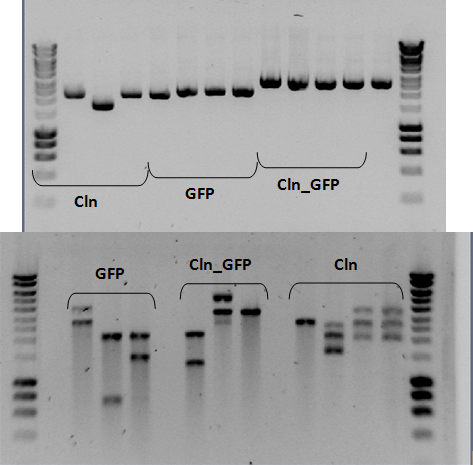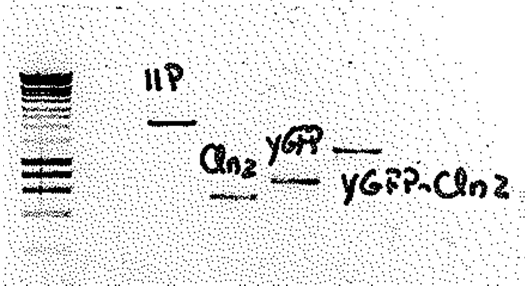Team:DTU Denmark/notebookredoxilator
From 2009.igem.org
| Line 184: | Line 184: | ||
<!-- INSERT MAIN TEXT HERE! (formatting: <b>bold</> <i>italic> <h4>header</h4>) --> | <!-- INSERT MAIN TEXT HERE! (formatting: <b>bold</> <i>italic> <h4>header</h4>) --> | ||
| - | <font size="4"><b>Activities relating to the redoxilator</b></font><br> | + | <font size="4"><b>Activities relating to the redoxilator</b></font><br><br> |
<font size="3"><b>July 20th</b></font><br> | <font size="3"><b>July 20th</b></font><br> | ||
| Line 190: | Line 190: | ||
</html> | </html> | ||
| - | [[image:DTUgel1.jpg]] | + | [[image:DTUgel1.jpg|300px|center|]] |
<html> | <html> | ||
<p align="center"><i>Figure 2: Restriction analysis of the three biobricks.</i> | <p align="center"><i>Figure 2: Restriction analysis of the three biobricks.</i> | ||
| Line 201: | Line 201: | ||
<font size="3"><b>July 17th</b></font><br> | <font size="3"><b>July 17th</b></font><br> | ||
| - | <p align="justify">Construction of biobricks: | + | <p align="justify">Construction of biobricks: Following purification, all of the PCR product was digested with <i>Xba</i>I (60U) and <i>Spe</i>I (30U). The mixtures were incubated at 37ºC. After 8 hours of incubation, more enzyme was added (<i>Xba</i>I (20 U) and <i>Spe</i>I (10U)) to ensure maximum digestion. Following enzymatic purification a gel was run to estimate the concentration of the vector and the PCR product (see figure 1).</p><br> |
| + | |||
| + | </html> | ||
| + | [[image:DTUgel2.jpg|300px|center|]] | ||
| + | <html> | ||
| + | <p align="center"><i>Figure 1: Electrophoresis gel picture of the PCR products of the three biobricks and the vector. The band 11P at 1500 bp corresponds to the vector; the three other bands at 537 bp, 207 bp and 125 bp correspond to the fragments Cln, GFP and Cln_GFP respectively.</i> | ||
| + | |||
| + | <p align="justify">To meet the 3:1 ratio of fragment to vector 12μl fragment was mixed with 2μl vector, 2μl ligase buffer (10x), 1μl ligase, 3 μl Mq H20. The ligation of the fragment and the vector was carried out on PCR machine using a 3:1 ratio for 1.5 hours using the idea by Lund, A. H., M. Duch, and F. S. Pedersen. 1996. Increased cloning efficiency by temperature-cycle ligation. Nucleic Acids Res. 24:800-801. doi:l50400 [pii]. | ||
| + | The final product was finally transformed into competent E coli cells.</p><br> | ||
<font size="3"><b>July 16th</b></font><br> | <font size="3"><b>July 16th</b></font><br> | ||
Revision as of 19:23, 20 October 2009

| Home | The Team | The Project | Parts submitted | Modelling | Notebook |
|
Activities relating to our two sub-projects: - The Redoxilator - The USERTM assembly standard |
Day-to-day activities Activities relating to the redoxilator July 20th Construction of biobricks: The restriction products were evaluated on a 1% agarose gel (see figure 2).
Figure 2: Restriction analysis of the three biobricks.
July 19th Construction of biobricks: The three plasmids were purified according to the protocol (link to protocol). Following the purification of the plasmids, a restriction analysis was performed using SpeI enzyme (10U) and incubated at 37ºC overnight. July 18th Construction of biobricks: Some colonies were picked from the transformation plates and made overnight cultures in liquid media. July 17th Construction of biobricks: Following purification, all of the PCR product was digested with XbaI (60U) and SpeI (30U). The mixtures were incubated at 37ºC. After 8 hours of incubation, more enzyme was added (XbaI (20 U) and SpeI (10U)) to ensure maximum digestion. Following enzymatic purification a gel was run to estimate the concentration of the vector and the PCR product (see figure 1).
Figure 1: Electrophoresis gel picture of the PCR products of the three biobricks and the vector. The band 11P at 1500 bp corresponds to the vector; the three other bands at 537 bp, 207 bp and 125 bp correspond to the fragments Cln, GFP and Cln_GFP respectively. To meet the 3:1 ratio of fragment to vector 12μl fragment was mixed with 2μl vector, 2μl ligase buffer (10x), 1μl ligase, 3 μl Mq H20. The ligation of the fragment and the vector was carried out on PCR machine using a 3:1 ratio for 1.5 hours using the idea by Lund, A. H., M. Duch, and F. S. Pedersen. 1996. Increased cloning efficiency by temperature-cycle ligation. Nucleic Acids Res. 24:800-801. doi:l50400 [pii]. The final product was finally transformed into competent E coli cells. July 16th Construction of biobricks: July 15th Construction of biobricks: July 14th Construction of biobricks: July 13th Construction of biobricks: |
Work process Our team works parallel in smaller sub-teams. Some of us work hard in the lab, while others are in the process of developing software and the in silico model of the Redoxilator system. However, we constantly keep each other updated, and meet often to exchange ideas and take turns at the different tasks, thus exhausting all of our combined knowledge in every aspect of this project. |
| Comments or questions to the team? Please Email us -- Comments of questions to webmaster? Please Email us |
 "
"


